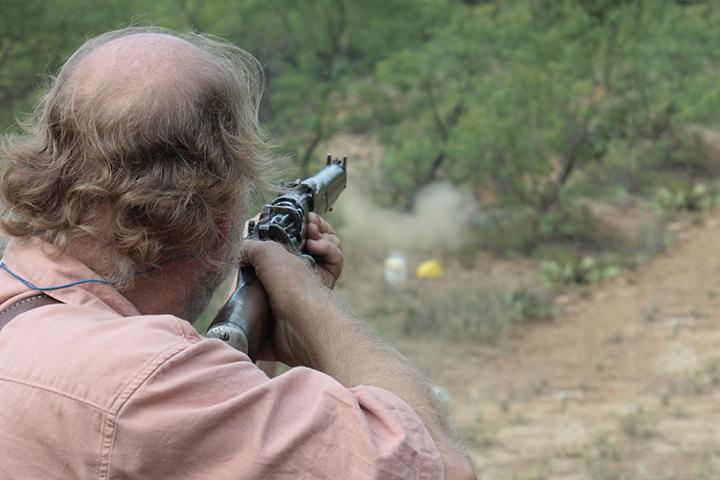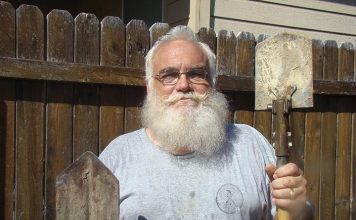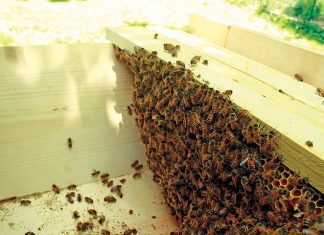 |
|
| Issue #97 • January/February, 2006 |
Jeff Yago, Backwoods Home‘s energy writer, recently completed a couple of concealed carry handgun courses. The classes apparently left some questions hanging in the air, and Jeff passed along a request through Dave Duffy for those questions to be addressed in this space. Here goes.
Question 1: “What are the basic differences in handguns to help determine which is better for home defense, ease of operation (single versus double action), male or female, caliber, number of cartridges?”
The question covers a lot of ground, so the answer has to be a bit basic.
A double action revolver with swing-out cylinder is easier in terms of administrative handling (loading, unloading, checking, cleaning) than any semiautomatic pistol. This is a decisive advantage for new shooters, or those who don’t spend much time maintaining their handgun skills. Many of today’s auto pistols are extraordinarily reliable, but if you compare all revolvers with all “automatics,” the revolvers win out in terms of certainty of firing without malfunction. Revolvers are also less maintenance intensive: they don’t need constant lubrication because they don’t have the long bearing surfaces that are at work within an autoloader’s mechanism as it is operated.
The downside of the revolver is less firepower: in the calibers you’d want for self-defense, cartridge capacity is somewhere between five and eight. Even with a speedloader, a revolver is slower to load and reload than is the semiautomatic, with its fast-inserting cartridge magazine. Under stress, you want to shoot the revolver double action, which means a long, heavy trigger pull for every shot. Most auto pistols are “self-cocking,” so at least after the first shot, and with some designs even with that first round, you have a shorter, lighter trigger pull that is easier for most people to manage when trying to shoot accurately at speed.
|
The semiautomatic generally holds more cartridges and is faster to reload, and can be had in models with a manual safety catch feature. This device can slow down an unauthorized person who doesn’t know that particular gun, gets his hands on it, and tries to shoot it. Many cops, and some armed citizens, are alive today because the homicidal felon who got their gun away from them and tried to shoot them with it didn’t know how to release the thumb safety.
Male or female? It’s less about gender than about hand size and shooting experience. A home defense gun is a “pool weapon,” like the shotgun in a police patrol car that’s on the road for three shifts a day: multiple individuals may be resorting to the same weapon. This means that the gun’s size and power have to be tailored to the smallest, least physically capable shooter who is authorized to use it. A large man can easily shoot his wife’s short-stocked 20-gauge shotgun or her slim-gripped SIG P239 9mm, but she will be awkward, clumsy, and poorly prepared to defend herself with his long-stocked 12 gauge, or his fat-handled .50 caliber Desert Eagle, which also requires a long finger to properly reach the trigger.
How many cartridges? I personally like a high capacity semiautomatic for home defense, because when you grab a gun in the middle of the night there isn’t always time to grab spare ammo. However, the fact is that the overwhelming majority of home defense applications of a gun are over in less than five or six shots. The revolver has a good history in defending home and hearth.
I would recommend the .38 Special (revolver) or 9mm Luger (auto) as minimum caliber in a defensive handgun. The smaller the caliber and the heavier the gun, the lighter the recoil; the more powerful the cartridge and the lighter the gun, the harder it will “kick.” The rule of thumb is that you should choose the most powerful gun that can be controlled in accurate rapid fire by the least physically capable person who is authorized to use it. The .40 and .45 caliber semiautomatic pistols aren’t hard to control with proper techniques and a good level of familiarity. Larger caliber revolvers kick more and require more training and practice to control and hit with at high speed.
Question 2: “(Please discuss) basic types and calibers of ammunition, and which is better for home defense, target practice, varmints, etc.”
Home defense rounds should be hollow points (HP), for the same reason that this type of ammo is universal among American police. The HP is designed to expand into a mushroom shape as it passes through flesh. This slows it down and reduces its penetration, making it unlikely that the projectile will pass through the felon’s torso and go on to strike a bystander who was blocked from the shooter’s position by the bulk of the criminal he shot.
|
Shaped like a cookie cutter at its nose, the hollow point is less likely to ricochet at a dangerous and unpredictable angle because where a round nose bullet might glance, the HP tends to bite into the surface and buries itself safely there. The expanding bullet also creates a wider wound channel that imparts more force to the intended target, helping to ensure a more rapid cessation of hostile activity. This is why HPs are better “man-stoppers” than standard ammunition.
There are some exotic cartridges sold for defense, such as ultra-light projectiles designed to break up on impact at extremely high velocity. The trouble with these is that they don’t always work in semiautomatic pistols, having a different pressure curve than the standard ammunition that the weapon’s slide mass and spring compression ratio were developed for at the factory. They are also very expensive, and it can cost up to $600 to run the requisite 200 rounds of the “carry ammo” through the gun to be certain that it will work reliably. For this writer, that factor alone lets out the exotic self-defense loads.
For practice or training, once you know your pistol will work 100% with your chosen defense load, it’s much more economical to buy generic full metal jacket ammo. The more “trigger time” you deposit in the “long term muscle memory” bank, the more swift and skillful you’ll be if you have to fire an accurate rescue shot in the course of an emergency.
Reloading your own ammo is a fun hobby, and fits perfectly in the self-reliance mode that runs through the whole backwoods home ethos. At the same time, generic factory produced cartridges are so cheap these days, particularly in 9mm and .38 Special, that when you figure in what your time is worth, it’s often more cost effective to buy your practice ammo in bulk instead of making your own ammunition.
Consider special needs. In bear country, you want deeper penetrating bullets, and probably more powerful cartridges, than what you’d want for defense against a 200-pound erect biped. If there are poisonous snakes on the property, a revolver loaded with snake-shot cartridges for at least the first couple of chambers makes a lot of sense. There are many semiautomatic pistols that won’t cycle with snake-shot loads, which tend to have too light a recoil impulse to cycle a semiautomatic pistol’s slide. If the first shot at the cottonmouth misses, it’s a lousy time for your handgun to jam.
Question 3: “(Give us) a few basic common sense rules and laws. For example, in most states, you cannot draw a weapon on somebody just for catching them stealing your stuff. There has to also be a bodily threat to you. Then what can you do if faced with road rage, several bullies on a dark street, or a mugger if they have not shown a gun or knife, yet you have a gun?”
|
This question really covers a lot of ground. You could write a book about it. Oddly enough, I did. It’s called, In the Gravest Extreme: the Role of the Firearm in Personal Protection. Dave Duffy sells it through Backwoods Home, and you’ll find ordering information on page 94 of this issue.
Let me offer another reference. When Dave asked me to write for Backwoods Home some years ago, he asked me to kick off with a series exploring when private citizens could use the lethal force of a firearm in defense of themselves, their families, and others. You can find these in the Backwoods Home Sixth Year Anthology.
I’ll address one point right here, though. If I find a kid stealing a bike out of my back yard, no, I’m not going to pull a gun on him. However, if I find a burglar in my home, he’s definitely going to be at gunpoint. Convicted burglars I interviewed after their arrests told me that most of the time they either carried a weapon of their own, or armed themselves with something once they entered the home. Breaking and entering is a serious felony, and you have every right to take such a felon at gunpoint. You don’t shoot him for breaking in or stealing, but you prepare to shoot him if he attacks you.
You will often hear the figure quoted that only about 7% of burglars commit their crimes armed. That’s probably because only about 7% of burglars are caught red-handed at the scene. Most are arrested later when an investigation leads police to them. Their confession will typically include a statement like, “Gosh, officer, I wouldn’t carry a gun when I break into a house because I’m afraid of a higher penalty if I’m caught.” Yeah, right.
Queston 4: “When faced with a break-in attacker or other potential threat to your life, where do you aim, how should you stand, how should you hold the weapon? In other words, with seconds to pull out a gun, most people will not have time to think ‘does the Weaver stance require my left or right foot forward?'”
Good points, Jeff, good points.
First, when you take a suspect at gunpoint, KEEP YOUR FINGER OFF THE TRIGGER! In a stressful moment like this, any number of stimuli can cause a convulsion of the trigger finger that kills an unarmed man who has just surrendered to you. Dr. Roger Enoka, the physiologist who has most authoritatively studied this phenomenon, enumerates various causes: startle reflex, postural disturbance, inter-limb response, and so on.
It’s not enough to rest the finger on the edge of the trigger guard. The tight muscles of your hand will hold the finger taut there, and if you are startled, the finger can snap straight back to the trigger, unintentionally firing the gun. The trigger finger should be up on the frame of the firearm, handgun, or long gun.
At the classes we teach around the country for Lethal Force Institute (www.ayoob.com), we urge that the fingertip be in contact with the frame, pointed inward toward the gun, with the trigger finger flexed. That way, if the strong flexor muscles of the hand convulse, the finger comes across the trigger instead of straight into it, and is thus much less likely to cause an accidental discharge. It’s also faster to get to the trigger if you do have to fire, if you start with the finger flexed on the frame.
For many years, I’ve made a point of leveling the gun at the pelvis of everyone I took at gunpoint. The main reason is that this point of aim allows you to see the suspect’s hands. If you aim at his head or chest or belly, your gun and your hands block your view of his hands. Man is the tool-bearing mammal, and therefore by definition the weapon-bearing mammal. A man will kill you with his hands. Thus, the Golden Rule of law enforcement: “Watch their hands!”
|
With the gun leveled groin high, you’ll be able to see in time if the suspect reaches for a weapon in his belt or in his pocket. If your gun is blocking your view of his hands, your first indication that you need to shoot will be when his bullet punches into your body. Talk about being behind the curve.
When a man perceives a firearm aimed at his private parts, a tremendous psychological effect is also engendered. A lot of bad guys have been shot or stabbed before, and have a lot of ego invested in having survived it. More of them have role models they met on the street or in prison who showed off the bullet scars on their torsos. This can reduce their fear of being shot in the trunk of the body. But NOTHING reduces a man’s fear of being shot in the genitals. This point of aim seems to definitely get their attention, in my experience.
If you do have to fire, a shot at the pelvis is angling downward. This reduces the chance of an exiting or missing shot striking a bystander a distance behind the felon, who was blocked from your view by the criminal’s body or by the tunnel vision that so often afflicts people involved in these situations. Finally, the pelvic area tends to produce dynamically “man-stopping” gunshot wounds. They tear up the lower abdominal viscera frightfully, and if the pelvis is smashed, the cross-member of skeletal support is compromised and the body almost always collapses.
Some advocate aiming the gun at the ground or floor ahead of the offender. One theory for this is that it reduces the crime of Aggravated Assault to that of Brandishing a Firearm. I say that’s rubbish: it is no crime to point a gun at a felon you have caught in your home, or an armed criminal about to attack you on the street. A more reasonable argument for aiming at the ground ahead of the subject is that if your gun accidentally discharges, the shot hits the ground and not a human being who has not yet done anything to warrant his being killed or injured.
That’s a good argument as far as it goes. My concern with it, however, is that criminals are predators, and predators are seasoned observers of body language. Pointing the gun at the ground instead of at him can lead him to believe, “This person doesn’t dare even point the gun at me! Why should I worry that he might dare to pull the trigger?” If that happens, the critical deterrent effect of the gun can be lost. If he is emboldened sufficiently to attack, either you’ll have to blow him away or you might be hurt or killed yourself, and these are not mutually exclusive outcomes. Some I have taken at gunpoint with my weapon leveled at their pelvis have fled; as a cop, I must pursue, and as a civilian you do not have the right to shoot a fleeing criminal. Most criminals taken at gunpoint have surrendered; none have yet attacked. I want to keep it that way. This is why I will personally continue to index the weapon on the opponent’s pelvis when I take a person at gunpoint. The choice is yours.
As to stance, while the angled body position of the Weaver stance is still very popular, the Isosceles stance makes foot placement irrelevant. Both arms are locked straight out, putting the gun at body center, so it doesn’t matter which foot is forward. The big thing you want to be thinking about when taking someone at gunpoint is increasing the distance between you and him, and perhaps getting behind cover. Always remain alert for his potential accomplices, who may enter the scenario from directly behind you or from your flank.
Question 5: “For home defense, where is the best place to keep a handgun, where is a thief most likely to look, and if you do lock it up and keep the ammunition separate like all the anti-gun lobby says, how can you get it, unlock it, load it, and do all this most likely in the dark when you hear a strange noise at the back door when home alone?”
|
You’ve got it right, Jeff. You can’t jump in your car and respond to an emergency in time if you first have to open the hood and hook up its battery, and you can’t unlock two cabinets and bring gun and ammo together before an intruder kicking down your door is upon you.
For me, it has boiled down to two modes. During waking hours, I simply carry the gun. On my person, it is at once always immediately accessible to me, and always inaccessible to unauthorized hands. If the lifestyle doesn’t allow the handgun to be worn visibly, a compact, powerful handgun like the Ruger SP101 .357 Magnum snub-nose revolver can be worn comfortably and discreetly concealed, “24/7.”
When asleep, I keep the weapon at bedside. If there are children (or adults, for that matter) in the home who are not at the level of development where they can be trusted around firearms 100%, the handgun should be in a locked security box in the bedroom, preferably a design like the Gun Vault, which can be released by feel in the dark by punching a simple combination into an ergonomic and easily palpable keypad. I currently live alone, so I just leave the pistol on the floor beside the bed, concealed from any intruder’s view by what appears to be a casually dropped magazine.
I appreciate Jeff’s questions. The fact that the questions had been left hanging in the air shouldn’t be blamed on Jeff’s instructors. Most concealed carry courses just aren’t long enough to cover everything that needs to be covered in terms of law, tactics, ethics, weapon choices, psychological preparation, and of course skill at arms for those who might find themselves in harm’s way with a gun in their hand. This is why our baseline course at Lethal Force Institute— the LFI-I class geared for armed citizens—is scheduled at 40 hours. It takes that long to cover the essentials. For information on the internet, surf to www.ayoob.com.
For the same reason, a three thousand word article isn’t enough to cover it. That’s why I hope readers will forgive me for referring them to the other sources available through Backwoods Home Magazine.



















